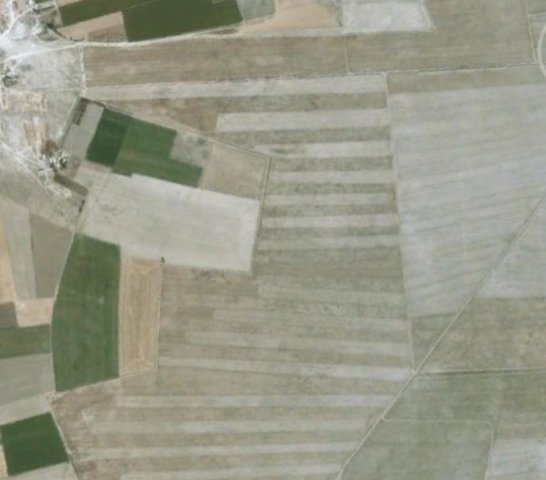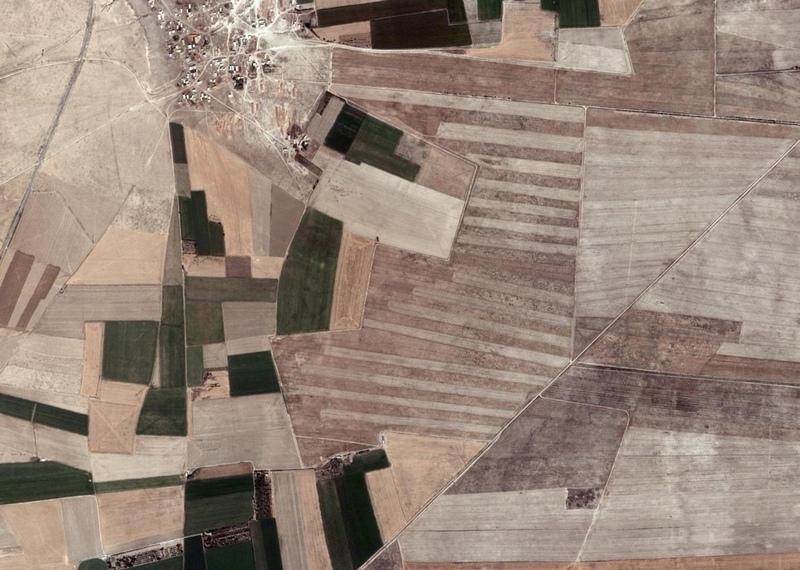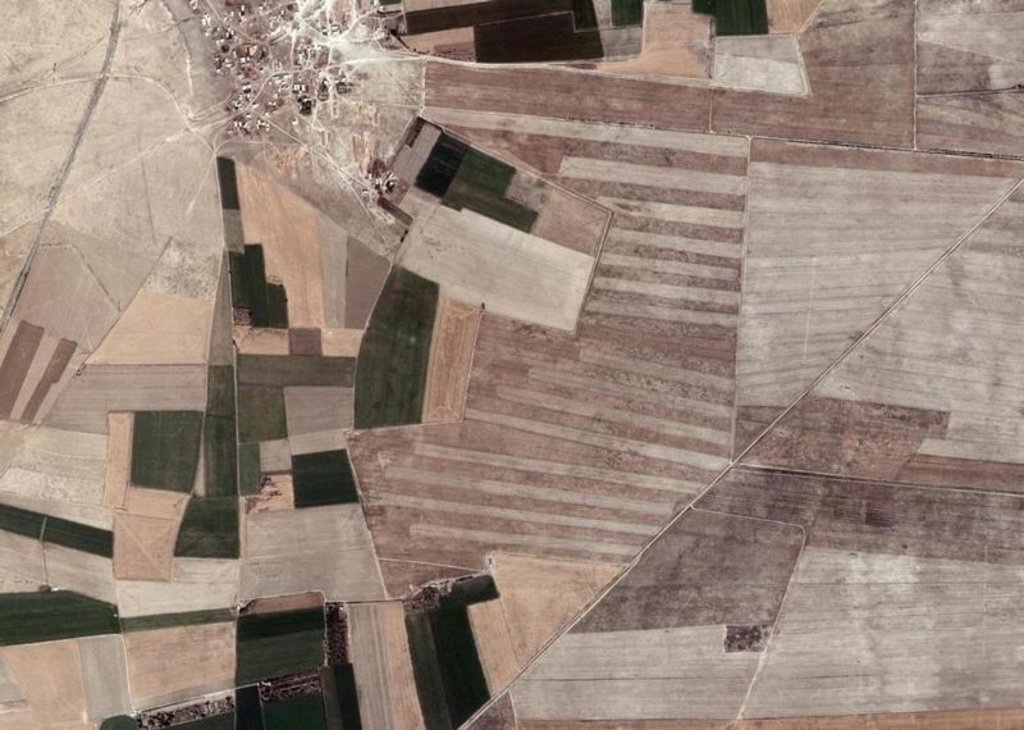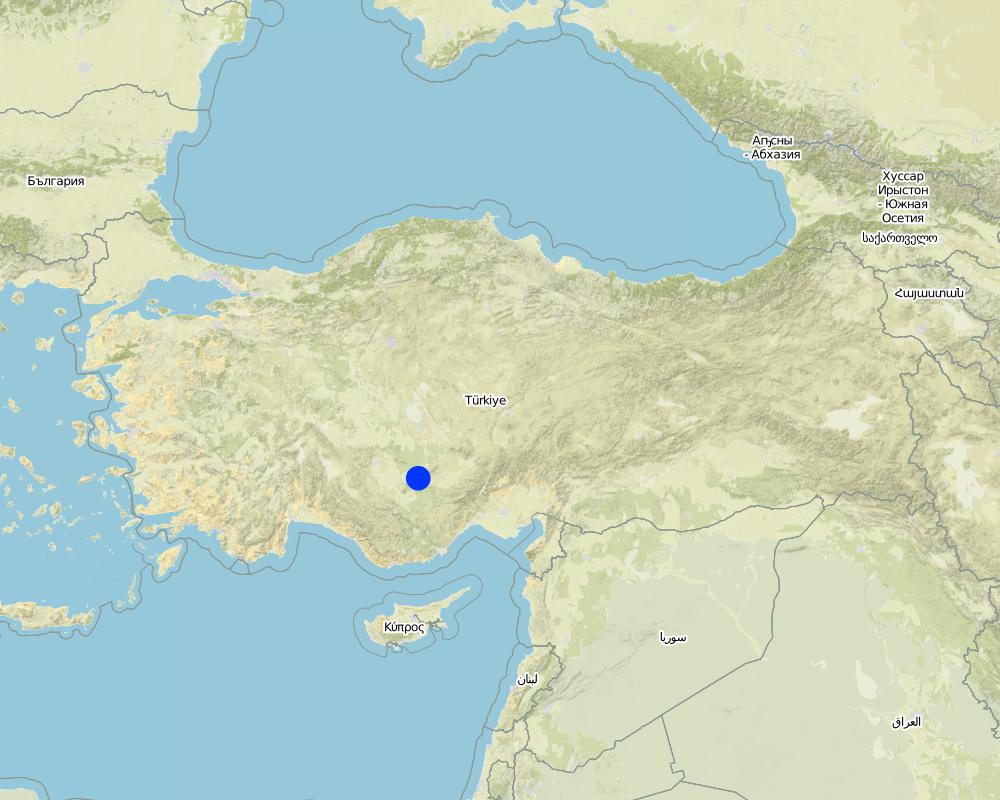Strip farming [土耳其]
- 创建:
- 更新:
- 编制者: Mehmet Zengin
- 编辑者: –
- 审查者: Fabian Ottiger, Alexandra Gavilano
Seritvari Tarim (Turkish)
technologies_995 - 土耳其
查看章节
全部展开 全部收起1. 一般信息
1.2 参与该技术评估和文件编制的资源人员和机构的联系方式
1.3 关于使用通过WOCAT记录的数据的条件
编制者和关键资源人员接受有关使用通过WOCAT记录数据的条件。:
是
1.5 参考关于SLM方法(使用WOCAT记录的SLM方法)的调查问卷

Crop Production [土耳其]
Adopting of the strip cropping-fallow-strip cropping system by farmers, with support from local SWC specialists and state agricultural organisations.
- 编制者: Mehmet Zengin
2. SLM技术的说明
2.1 技术简介
技术定义:
Strip farming is a kind of an agriculture method that cereals are sowed as strips which are 50 m witdh (strip-fallow-strip). Strips are perpendicular to wind direction in dropugth areas.
2.2 技术的详细说明
说明:
Cereals are grown as strip-fallow to conserve the soil from the wind. Cereal strip in current year will be fallowed next year while the fallowed strip in this yaer will be cereal strip in next year. Width of the strips should be 50 m and they have to be arranged perpendicular to wind direction. So can not move the soil as a wind erosion. Plant strip conserve the soil in their original place. Aim of this method is to conserve field soil in drought area. Field soil is keeped sown in every year as strip-fallow-strip in turn. In the system there is not much input. Field can not be sown in every year due to drought, but in can not be left as fallow compleately. Otherwise barren (without plant) soil losses by the wind. For this, the farmers must be informed in the drought regions. In the drought area (<400 mm annual precipitation), to conserve the soil in the field is very important with respect to environment. Because wind erosion both carries the soil and cause siltation (sedimentation) near the settlement areas.
2.3 技术照片
2.5 已应用该技术的、本评估所涵盖的国家/地区/地点
国家:
土耳其
区域/州/省:
Konya
有关地点的进一步说明:
Karapinar
具体说明该技术的分布:
- 均匀地分布在一个区域
如果不知道精确的区域,请注明大致覆盖的区域:
- 10-100 平方千米
Map
×2.6 实施日期
如果不知道确切的年份,请说明大概的日期:
- 10-50年前
2.7 技术介绍
详细说明该技术是如何引入的:
- 通过项目/外部干预
3. SLM技术的分类
3.2 应用该技术的当前土地利用类型

农田
- 一年一作
年作 - 具体指明作物:
- 谷类 - 大麦
- 谷物类 - 玉米
- 谷类 - 小麦(春季)
- 饲料作物 - 三叶草
- 根/块茎作物 - 甜菜
每年的生长季节数:
- 1
具体说明:
Longest growing period in days: 10Longest growing period from month to month: Oct - Jul

牧场
粗放式放牧:
- 游牧
注释:
Livestock density (if relevant):
25-50 LU /km2
Major land use problems (compiler’s opinion): Yearly precipitation (270 mm) is very low while evaporation is high (750 mm per year). Soils are shallowed by wind erosion and degradation. Additionally soil fertility is low and biomass is very poor. Plants are consumpting lots of water for growing. Strip farming is not prefered and drip irrigation is not used.
Major land use problems (land users’ perception): Irrigation water is not enough and pasture lands are very poor. The electric energy for the irrigation is very expensive.
Nomadism: sheep
3.4 供水
该技术所应用土地的供水:
- 雨养
注释:
Water supply: rainfed, full irrigation
3.5 该技术所属的SLM组
- 防风林/防护林带
3.6 包含该技术的可持续土地管理措施
3.7 该技术强调的主要土地退化类型

土壤风蚀
- Et:表土流失
- Ed:风蚀风积

生物性退化
- Bh:栖息地丧失
- Bq:数量/生物量减少
- Bs:质量和物种组成/多样性的下降
- Bl:土壤寿命损失
注释:
Main type of degradation addressed: Et: loss of topsoil, Ed: deflation and deposition
Secondary types of degradation addressed: Bh: loss of habitats, Bq: quantity / biomass decline, Bs: quality and species composition /diversity decline, Bl: loss of soil life
Main causes of degradation: droughts (drought is geting dominant and rain decreases.)
Secondary causes of degradation: soil management (crop management is not being done properly), deforestation / removal of natural vegetation (incl. forest fires) (trees and shrups were dejayed around in early times), population pressure (Population increasing attacks to the field and yield capacitiy is decreasing.), land tenure (Field is getting fragmentated by the inheritance.), education, access to knowledge and support services (Lack of technical informaton is hindering succesful farming.)
3.8 防止、减少或恢复土地退化
注释:
Main goals: prevention of land degradation
Secondary goals: mitigation / reduction of land degradation
Third goal: rehabilitation / reclamation of denuded land
4. 技术规范、实施活动、投入和成本
4.1 该技术的技术图纸
技术规范(与技术图纸相关):
Secondary technical functions: improvement of ground cover, increase in organic matter, increase in nutrient availability (supply, recycling,…), increase of infiltration, increase / maintain water stored in soil, increase of groundwater level / recharge of groundwater, sediment retention / trapping, sediment harvesting, reduction in wind speed, increase of biomass (quantity)
Contour planting / strip cropping
Material/ species: cereals
Quantity/ density: 450 grain
Remarks: strip-fallow-strip
Rotations / fallows
Material/ species: plants for strip cropping
Quantity/ density: normal
Remarks: strip-fallow-strip
4.2 有关投入和成本计算的一般信息
其它/国家货币(具体说明):
Turkish Liras
如相关,注明美元与当地货币的汇率(例如1美元=79.9巴西雷亚尔):1美元=:
13.0
注明雇用劳工的每日平均工资成本:
17.00
4.4 技术建立所需要的费用和投入
| 对投入进行具体说明 | 单位 | 数量 | 单位成本 | 每项投入的总成本 | 土地使用者承担的成本% | |
|---|---|---|---|---|---|---|
| 设备 | Machine use | ha | 1.0 | 77.0 | 77.0 | |
| 植物材料 | Seeds | ha | 1.0 | 230.0 | 230.0 | 90.0 |
| 植物材料 | Seedlings | ha | 1.0 | 230.0 | 230.0 | 90.0 |
| 植物材料 | Fertilizer | ha | 1.0 | 307.0 | 307.0 | 90.0 |
| 植物材料 | Biocides | ha | 1.0 | 77.0 | 77.0 | |
| 技术建立所需总成本 | 921.0 | |||||
| 技术建立总成本,美元 | 70.85 | |||||
注释:
Duration of establishment phase: 2 month(s)
4.5 维护/经常性活动
| 活动 | 时间/频率 | |
|---|---|---|
| 1. | Sowing | Authumn / once a year |
| 2. | Fertilizing | Authumn and spring / 2 times |
| 3. | Herbicide | Spring / once a year |
| 4. | Harvest | Summer / once a year |
4.6 维护/经常性活动所需要的费用和投入(每年)
注释:
Machinery/ tools: tractor, plough, sowing machine, pulverizator, fertilizing machine, harvest machine
The costs were calculated according to 2008 prices.
4.7 影响成本的最重要因素
描述影响成本的最决定性因素:
Seeds and fertilizers are the most expensive inputs.
5. 自然和人文环境
5.1 气候
年降雨量
- < 250毫米
- 251-500毫米
- 501-750毫米
- 751-1,000毫米
- 1,001-1,500毫米
- 1,501-2,000毫米
- 2,001-3,000毫米
- 3,001-4,000毫米
- > 4,000毫米
有关降雨的规范/注释:
In winter
农业气候带
- 半干旱
Thermal climate class: boreal
Seven months drought in a year
5.2 地形
平均坡度:
- 水平(0-2%)
- 缓降(3-5%)
- 平缓(6-10%)
- 滚坡(11-15%)
- 崎岖(16-30%)
- 陡峭(31-60%)
- 非常陡峭(>60%)
地形:
- 高原/平原
- 山脊
- 山坡
- 山地斜坡
- 麓坡
- 谷底
垂直分布带:
- 0-100 m a.s.l.
- 101-500 m a.s.l.
- 501-1,000 m a.s.l.
- 1,001-1,500 m a.s.l.
- 1,501-2,000 m a.s.l.
- 2,001-2,500 m a.s.l.
- 2,501-3,000 m a.s.l.
- 3,001-4,000 m a.s.l.
- > 4,000 m a.s.l.
5.3 土壤
平均土层深度:
- 非常浅(0-20厘米)
- 浅(21-50厘米)
- 中等深度(51-80厘米)
- 深(81-120厘米)
- 非常深(> 120厘米)
土壤质地(表土):
- 粗粒/轻(砂质)
- 中粒(壤土、粉土)
表土有机质:
- 低(<1%)
如有可能,附上完整的土壤描述或具体说明可用的信息,例如土壤类型、土壤酸碱度、阳离子交换能力、氮、盐度等。:
Soil fertility is: Low - medium
Soil drainage/infiltration is: medium
Soil water storage capacity is: medium
5.4 水资源可用性和质量
地下水位表:
5-50米
地表水的可用性:
匮乏/没有
水质(未处理):
不良饮用水(需要处理)
关于水质和水量的注释和进一步规范:
Ground water table 5-50m (It decreases in summer, increases in winter)
5.5 生物多样性
物种多样性:
- 低
关于生物多样性的注释和进一步规范:
Plant number and species are very low
5.6 应用该技术的土地使用者的特征
生产系统的市场定位:
- 混合(生计/商业)
非农收入:
- 低于全部收入的10%
相对财富水平:
- 贫瘠
- 平均水平
机械化水平:
- 机械化/电动
说明土地使用者的其他有关特征:
Population density: 10-50 persons/km2
Annual population growth: 0.5% - 1%
70% of the land users are average wealthy and own 30% of the land.
Level of mechanization: Mechanised (Every kind of machine is used )
5.7 应用该技术的土地使用者使用的平均土地面积
- < 0.5 公顷
- 0.5-1 公顷
- 1-2 公顷
- 2-5公顷
- 5-15公顷
- 15-50公顷
- 50-100公顷
- 100-500公顷
- 500-1,000公顷
- 1,000-10,000公顷
- > 10,000公顷
注释:
Average area of land owned or leased by land users applying the Technology: 15-50 ha, 15-50 ha, 50-100 ha
5.8 土地所有权、土地使用权和水使用权
土地所有权:
- 个人,有命名
土地使用权:
- 个人
用水权:
- 个人
5.9 进入服务和基础设施的通道
健康:
- 贫瘠
- 适度的
- 好
教育:
- 贫瘠
- 适度的
- 好
技术援助:
- 贫瘠
- 适度的
- 好
市场:
- 贫瘠
- 适度的
- 好
能源:
- 贫瘠
- 适度的
- 好
饮用水和卫生设施:
- 贫瘠
- 适度的
- 好
6. 影响和结论性说明
6.1 该技术的现场影响
社会经济效应
生产
作物生产
饲料生产
饲料质量
畜牧生产
生产故障风险
社会文化影响
SLM/土地退化知识
冲突缓解
Improved livelihoods and human well-being
注释/具体说明:
Strip farming improved environment ecology, decreased run-off water, stopped wind erosion, increased organic matter in the soil due to soil was not sowed in every year. In the fallow strip this year, cereals good grew next year.
生态影响
水循环/径流
水量
地表径流
地下水位/含水层
蒸发
土壤
土壤覆盖层
其它生态影响
Wind erosion
Soil livings
6.2 该技术的场外影响已经显现
风力搬运沉积物
注释/具体说明:
Strip farming system conserved soil particle in their site from wind power, so Karapınar city and Konya-Karapınar motorway got ride of soil particle mowing hazards.
6.4 成本效益分析
技术收益与技术建立成本相比如何(从土地使用者的角度看)?
短期回报:
积极
长期回报:
非常积极
技术收益与技术维护成本/经常性成本相比如何(从土地使用者的角度看)?
短期回报:
积极
长期回报:
积极
注释:
There is a not addition cost in this technology. Cereals are grown in the strips perpendicular to wind direction instead of wholly field.
6.5 技术采用
如若可行,进行量化(住户数量和/或覆盖面积):
580
在所有采用这项技术的人当中,有多少人是自发的,即未获得任何物质奖励/付款?:
- 11-50%
注释:
30% of land user families have adopted the Technology with external material support
290 land user families have adopted the Technology with external material support
Comments on acceptance with external material support: Karapınar’s farmers could not give up their habits. They know to sow with cereals field completely in one year and next year this field will be fallow. While the field is fallow, surface is open to wind. So, wind erosion will be strong.
30% of land user families have adopted the Technology without any external material support
290 land user families have adopted the Technology without any external material support
Comments on spontaneous adoption: Educated or open minded farmers adopted easily this technology. The others then adopted strip farming sowing system after see next door private or government field models.
There is a moderate trend towards spontaneous adoption of the Technology
Comments on adoption trend: Karapınar farmers adopted wholly this technology in dry areas anymore. But in the watering parts, they are growing watering plants such as sugar beet, corn, clover, sun flower, etc. now.
6.7 该技术的优点/长处/机会
| 土地使用者眼中的长处/优势/机会 |
|---|
|
easy How can they be sustained / enhanced? To attantion |
| 编制者或其他关键资源人员认为的长处/优势/机会 |
|---|
|
Low expensive, usable, adoptable. How can they be sustained / enhanced? By the training. |
6.8 技术的弱点/缺点/风险及其克服方法
| 土地使用者认为的弱点/缺点/风险 | 如何克服它们? |
|---|---|
| Lack of technical knowledge. | By information. |
| 编制者或其他关键资源人员认为的弱点/缺点/风险 | 如何克服它们? |
|---|---|
| If the wind paralel long edge of the field contour strip cropping is not done by farmers. | Training. |
7. 参考和链接
7.1 信息的方法/来源
链接和模块
全部展开 全部收起链接

Crop Production [土耳其]
Adopting of the strip cropping-fallow-strip cropping system by farmers, with support from local SWC specialists and state agricultural organisations.
- 编制者: Mehmet Zengin
模块
无模块




